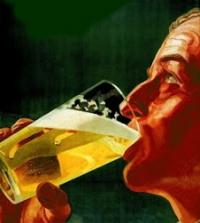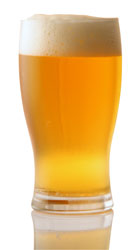
German Pilsner
#1

Posted 09 June 2009 - 12:13 PM
#2

Posted 09 June 2009 - 01:06 PM
#3

Posted 09 June 2009 - 01:41 PM
Thanks for the input, Ken. I guess what I was thinking with the Crystal 20 is that it might provide a hint of the melanoidins you would get if you did a decoction mash. Maybe I'll grab some Vienna from my LHBS and substitute that for the C-20 if you think that would work better. How much Vienna would be a good amount? A quarter or a half pound maybe? Does the Carapils quantity I'm showing look about right? I think I'll be good with my water because my tap water is extremely soft, very close to Pilsen's. The only thing I need to do according to Palmer's spreadsheet is add some hardness (calcium) to get the mash pH down into range. I was going to add small, balancing amounts of calcium chloride and gypsum to make the adjustment, keeping the sufate to chloride ratio balanced for taste.It looks nice. That's one of my favorite yeasts and one that I would certainly suggest. I don't care for the Crystal 20°L in the recipe and it's probably not authentic, IMO. When I do something like this, I'll go with pilsner or 2-row (I think the 2-row is fine, btw), some Vienna or Munich and maybe some Carapils and/or Carafoam in small amounts. The Crystal 20 is a very small amount (less than 4 oz?) so I wouldn't sweat it. My only other suggestion would be to pay attention to your water. I only say this because my tap water is on the hard side. I have made pilsners with 100% filtered tap water and the finish ends up kind of clunky, not smooth. I can filter it to get the chlorine out and make some great beer. But pilsners really benefit from softer water so maybe some spring water or distilled/RO mixed with normal tap water would work. I have been in the habit of adding distilled to my filtered tap water for beers in this style. Good luck.
#4

Posted 09 June 2009 - 03:47 PM
#5

Posted 09 June 2009 - 05:28 PM
Thanks for the insight. This will be my first real pilsner, so I appreciate having some experience to draw upon here. The consensus so far is drop the C-20, so I will do that. I'll see if my brew shop has any honey malt and will consider adding a few ounces of that. I'm inclined to just skip the decoction process, as I'd like to keep this one on the simple side, as long as it will still be in style. I was using Tettnanger throughout because I have a pound of it on hand. I would think it would be ok to use Tettnanger for bittering, since noble hops were traditionally used for bittering additions in German Pilsners.No way 20L is going to taste like anything but crystal. A touch of crystal might be nice in the beer, but for style purposes it would be out of place. ("But it's just a little!" Yeah, just a little out of place, like .5oz roast in a German Pils, also a tasty idea.) Lose the crystal and don't worry about the decoction. if you like, you can do a thin decoction (runoff about a gallon, add a half-gallon of mash and boil it till at least hotbreak) to infuse up to mashout temps, and get some melanoidin production, also leaving some hot break behind in the mash. You can also just do a single infusion and have a great pils. Ken, I'm surprised to hear you recommend Munich/Vienna. My favorite German Pils is just Weyerman pils with a touch of carafoam to about 1.050-52 (on the big side), a touch of calc/chlor in the kettle, and some acid malt if your water needs it. Magnum is a good one for this style. It's smooth enough to take you up to 40 IBU without getting aggressive. Then a bit (or more) of Hallertau or Tettnanger in the finish. If you're looking for a bit of color and malt backbone, consider Honey Malt. It's pertty much a clone of the old Brumalt that we can't get. Gives an awesome "light honey" malty sweetness that would be great in this style. I'd suggest 2-3oz as a starting point, but you might go as far as 6oz.
#6

Posted 09 June 2009 - 07:46 PM
#7

Posted 09 June 2009 - 09:28 PM
#8

Posted 10 June 2009 - 05:49 AM
#9

Posted 10 June 2009 - 09:37 AM
#10

Posted 10 June 2009 - 10:38 AM
#11

Posted 10 June 2009 - 12:28 PM
I think you're on the right track. I definitely would not add crystal, vienna, or munich if you're trying to make a traditional german pils. A touch of carapils or carafoam should be ok, but even that isn't really needed in my opinion. A high quality continental pils malt would make a big difference, but do it with the Breiss 2-row now, and then compare to the same recipe made with cont pils malt later. I'd mash in the 148-150F range to get the beer to dry out as it should. Tetts all the way through should be great (by the way, I agree that Magnum is a perfect hop for bittering the style, and is in fact commonly used). WLP830 or 838 would both work well. I also think your approach to water treatment sounds good. German pils do not benefit from really soft water. Anyone who has Jamil's Brewing Classic Styles care to chime in? I'm curious what he has for a recipe for a german pils.Everyone's comments are very much appreciated. Taking comments into account, and reading up on the style, I've decided to keep it simple and basic. I plan to use only 9 lbs. of 2-row, and 12 oz. of Carapils, both of which I have on hand. I would have definitely preferred to use German Pilsner malt instead of the 2-row, but 2-row is what I have on hand. So, I'll use that and see how it comes out. It should make a good baseline for comparison when I make it later using Pilsener malt. Based on Ray Daniels book, I'll shoot for a mash temp of 151 F instead of 148 F. This should give a little bit more malt sweetness for balance, but should still have good attentuation and a dry finish per style. I will increase the earlier hops to get the IBUs up around 40, sticking with Tettnanger, because that is what I have on hand. By balancing gypsum additions with calcium chloride additions, I'll be able to hit mash pH, and at the same time, add some more sulfates to the water to give a the bitterness more crispness, as dictated by style.
Edited by NWPines, 10 June 2009 - 12:31 PM.
#12

Posted 10 June 2009 - 02:18 PM
Thanks, I know from my past brewing experience that I will inevitably learn a number of lesson the hard way when I try a new style, but hopefully can pre-empt some of the mistakes I will make by listening to the voices of experience. I'd also be interested to know the German Pils recipe in Brewing Classic Styles.I think you're on the right track. I definitely would not add crystal, vienna, or munich if you're trying to make a traditional german pils. A touch of carapils or carafoam should be ok, but even that isn't really needed in my opinion. A high quality continental pils malt would make a big difference, but do it with the Breiss 2-row now, and then compare to the same recipe made with cont pils malt later. I'd mash in the 148-150F range to get the beer to dry out as it should. Tetts all the way through should be great (by the way, I agree that Magnum is a perfect hop for bittering the style, and is in fact commonly used). WLP830 or 838 would both work well. I also think your approach to water treatment sounds good. German pils do not benefit from really soft water. Anyone who has Jamil's Brewing Classic Styles care to chime in? I'm curious what he has for a recipe for a german pils.
#13

Posted 10 June 2009 - 06:00 PM
#14

Posted 10 June 2009 - 06:55 PM
#15

Posted 10 June 2009 - 07:01 PM
As far as the Brewing Classic Styles recipe goes you're getting pretty close. You might mash at the original temp, drop the FWH and cut the flavor and aroma hop additions in half plus your plan of increasing the 60 min hops. 40 IBU is a few IBU higher than JZ's recipe. FWIW all the recipes I've brewed from his book so far have been really f'in good. Sounds like a great beer to have around for the summer. I am going to keg 10 gallons of BoPils this weekend and can't wait to tap 'em! Good luck with the German Pils, let us know what you brew, which yeast you use and how it turns out. EDIT: Oops, looks like someone just posted JZ's recipe9 lbs. of 2-row, and 12 oz. of Carapils, both of which I have on hand. Based on Ray Daniels book, I'll shoot for a mash temp of 151 F instead of 148 F. This should give a little bit more malt sweetness for balance, but should still have good attentuation and a dry finish per style. I will increase the earlier hops to get the IBUs up around 40, sticking with Tettnanger, because that is what I have on hand. By balancing gypsum additions with calcium chloride additions, I'll be able to hit mash pH, and at the same time, add some more sulfates to the water to give a the bitterness more crispness, as dictated by style.
#16

Posted 10 June 2009 - 07:28 PM
#17

Posted 12 June 2009 - 09:25 PM
Not to mention it's a much better choice than a Bohemian Lager yeast. 830 will not stand out in any assertive way, which is why it's among the most popular, and a good one for this style. Call it the "Chico" of lager strains.I'm locked into using the WLP830, because I have a tube of it in the fridge.
#18

Posted 12 June 2009 - 09:33 PM
The Wyeast 2124 is the same as the 830. Also known as the W-34/70 strain.Not to mention it's a much better choice than a Bohemian Lager yeast. 830 will not stand out in any assertive way, which is why it's among the most popular, and a good one for this style. Call it the "Chico" of lager strains.
#19

Posted 13 June 2009 - 06:56 AM
#20

Posted 13 June 2009 - 08:21 AM
1 user(s) are reading this topic
0 members, 1 guests, 0 anonymous users











